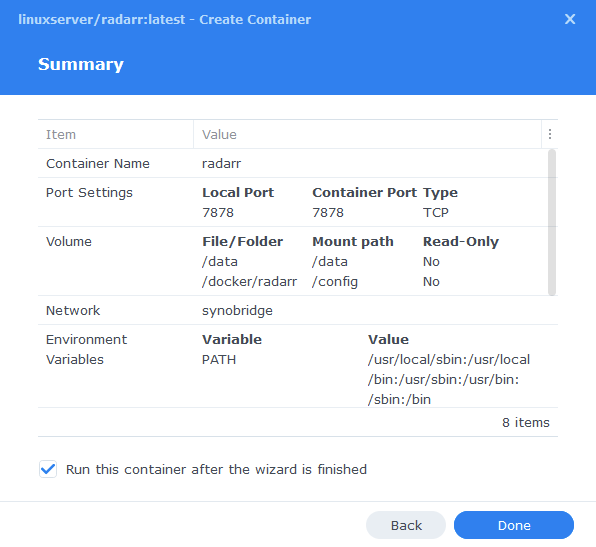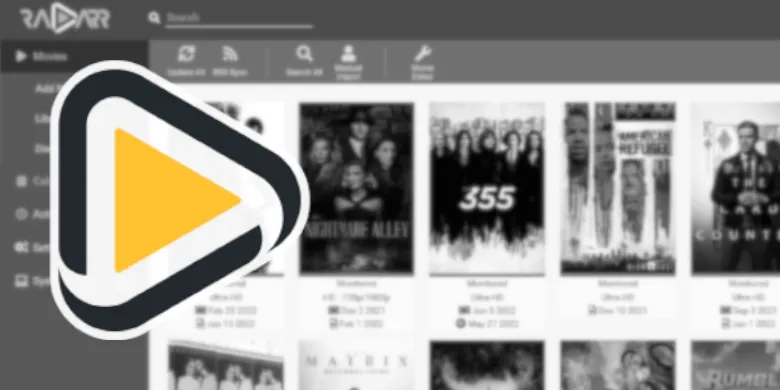Please note if you are using DSM7.2 or higher you should use the Container Manager version of this guide from the menu.
This guide has reached the end of its updates as most people are now on the latest DSM update - This guide is correct as of 08/12/2023 however no further updates will be added.
| Update | Date |
|---|---|
| Removed docker compose section as rarely used | 18/07/2023 |
What is Radarr?
Radarr is used to search, download and organise your Movies in conjunction with your preferred Usenet or Torrent downloaders and indexers.
Let’s Begin
In this guide I will take you through the steps to get Radarr up and running in Docker.
In order for you to successfully use this guide please complete the three preceding guides
- Step 1: Directory Setup Guide
- Step 2: Setting up a restricted Docker user
- Step 3: Setting up a Docker Bridge Network
Downloading the Radarr Image
Open up Docker within DSM and navigate to the ‘Registry’ tab and search for ‘Radarr’. In the list of available containers select the one made by Linuxserver as shown below then click ‘Download’.

The pop-up box will ask which version you want to download, make sure you choose ‘Latest’ from the list of available versions.

You can check the status of the download over on the ‘Image’ tab.
Setting up the container
In Docker click on the ‘Image’ tab, in the list of your containers select the ‘Linuxserver Radarr’ image and click on ‘Launch’
You will be greeted with the Network screen, we will be using the ‘synobridge’ network we created earlier select it from the list and click Next.

General Settings
Next you will be greeted with the General Settings screen, this is where you can start specifying some of your preferences.
You can change the name of the container to anything you like, and you may want to enable Auto Restart as this will ensure Radarr starts automatically if you reboot your NAS.
You will also notice a Configure capabilities button — don’t change anything in here!

Next up we are going to click on the ‘Advanced Settings’ button, this will take you to a new window with a number of tabs which we are going to work through.
Environment (PGID, PUID and Timezone)
Next we are going to set up a couple of environment variables that docker will use to allow the container access to our files and folders and also to tell it where we live in the world.
Click the Add button, and fill in the following details as per the table/screenshot, you will need to do one at a time.
| Variable | Value |
|---|---|
| PUID | The UID you obtained in the user setup guide |
| PGID | The GID you obtained in the user setup guide |
| TZ | Your timezone wikipedia.org/wiki/List_of_tz_database_time_zones |

Links / Execution Command
You do not need to set up anything on these tabs.
Press ‘Save’ to go back to the initial setup screen, then press ‘Next’
Port Settings
We won’t be changing any of the ports the container uses. You can repeat the ones shown on the right side of the settings page ‘Container Port’ onto the left side ‘Local Port’ once you have done this press ‘Next’.

Volume Settings
We will now be specifying the directories where Radarr will store its configuration files and where to find our media and downloads.
Click on ‘Add Folder’ select the ‘docker’ folder and create a new sub-folder called ‘radarr’ select this folder and click ‘select’
Repeat this process to add the /data folder.

You will now add the below settings into the ‘Mount path’ section
| File/Folder | Mount path |
|---|---|
| docker/radarr | /config |
| data | /data |

Click Next to move to the final screen.
Summary
You have now completed the setup of the container.
You will be shown an overall summary of the settings we have specified, this is a good time to double-check everything is correct. Finally, click on Done and the container should start to boot.

You should now be able to access Radarr via the IP of your NAS followed by the port 7878
e.g., 192.168.0.40:7878
Key Settings and FAQ
Now you have set up Radarr there are some key settings you will need to set as these often catch new users out. I will add more as they come up.
Media Management / Root Folders (Settings>Media Management)
Radarr refers to the place(s) you keep your movies as Root Folders. These are where Radarr will ultimately move your movies to once they finish downloading.
| App | Root Folder |
|---|---|
| Radarr | /data/media/movies |
Download Clients (Settings > Download Clients>Remote Path Mappings)
While most of the settings on this page are self-explanatory something that has caught people out if the Remote Path Mappings setting. If you are hosting all your services on the same NAS do not add any settings here.
I can’t get Radarr to Connect to my Download Client!
When setting up your preferred download client or Prowlarr etc. Usually you will use the IP of your NAS, however if for whatever reason this is not working you can use http://172.20.0.1 which is the IP of the ‘synobridge’ gateway.
| Historic Updates | Date |
|---|---|
| Added Docker Compose details Added new folder mappings to ensure atomic moves and Hard-linking | 03/05/2021 |
| Guide re-written and updated with DSM7 screenshots | 01/08/2021 |
| Updated screenshots and steps for DSM7.1 | 03/06/2022 |
| Added new port settings and Docker Bridge Network | 23/07/2022 |
| Compose version number removed and small wording amendments | 08/04/2023 |
| Amended the path to save the compose file – this is for security, so the container has no access to the file contents. | 14/04/2023 |
Buy Me a Coffee or a Beer
If you have found my site useful please consider pinging me a tip as it helps cover the cost of running things or just lets me get the odd beverage. Plus 10% goes to the devs of the apps I do guides for every year.



Thank you for your wonderful guides! They have incredibly helpful getting things set up for my Synology NAS with docker.
The only thing is that I am running into a problem with the radarr install.
I followed everything to the letter and when trying to connect to radarr through port 7878 I get a “This site can’t be reached”. All other containers are working fine.
I have double and triple checked the settings, deleted the container, index and reinstalled, and rebooted the NAS.
When looking at the folder structure for radarr it is empty. Also, when checking the log files it says that the service has successfully started but I don’t see anything referencing ports.
Any help is appreciated. Thanks!
Hey Will, First thing to triple check if all the other Arrs are working is the PUID and PGID, and they have been entered the right way around e.g. PGID is 100 and the PUID is the 4 digit one. As this is the usual culprit behind permission issues. Especially if the others have had no problems running, second this is to make sure when on the ‘Port Settings’ screen that you have set the External Port as 7878 in line with the internal port of 7878.
Let me know if that works, if not reach out via the contact page as a bit easier to talk through.
Good news, Posting this for anyone else who is running into problems. I found that if I used an older version of Radarr 3.2.2 everything will load. I am running DSM 6.2 and doesn’t support the newer radarr builds without changing to a new NAS that supports DSM 7+. Hope this helps.
Thanks Will. Do you know what the conflict is as everything Radarr uses is inside the container.
From what I found the conflict is that DSM 6 can’t handle the kernel for the NAS is too old and isn’t compatible. In the /r/radar subreddit it is the Radarr via Docker on Synology NAS doesn’t start, thread.
Time to update my NAS I guess!
Hey,
thanks for this amazing guide.
I just could not get the docker compose part to work. In the initial setup I used terminal to SSH and it all worked well. The only error I had was (in case that helps with troubleshooting):
Could not chdir to home directory /var/services/homes/NAS223: No such file or directory
Regarding the docker compose part: in my docker folder there is no radarr.yml. And if I paste the command from this guide with my own values in terminal, I get “path not found”.
What do you recommend me to do?
Cheers
Hey, if you have already done the main steps of the tutorial you don’t need to do the Docker compose section, it’s an alternative method.
Do you have any guides on how to access Radarr, Sonarr, etc. containers (set up with your instructions) from outside my home network?
Hey, while not specific to Radarr you can follow the instructions in the Overseerr/Jellyseerr guides from the DDNS section onwards.
Thanks!
Off topic, have you considered a guide for Whisparr?
Another Arr to add to the list lol. Hadn’t heard of that yet..
I’d assume the setup for Whisparr is pretty much like Sonarr or Radarr, I just am not sure what image to downlonad. 🙂
Use the hot.io version same setup
https://hotio.dev/containers/whisparr/
Awesome! I was able to set up access to all of my containers via your reverse proxy instructions except for tautulli. Do you know if there are additional settings in the tautulli app that need to be adjusted for that to work?
I don’t have this behind a reverse proxy to test, there is an option in the settings, Web Interface (Enable Advanced) ‘Enable HTTP Proxy’ Respect the X-Forwarded-Proto header. Used for reverse proxies with SSL.
My Radarr have lost it’s Root Folder after installing following your auto-updater for containers guide. Is there a way to edit a image? instead of creating a new? or what difference does this do? Do i just create an new and delete the old or will this have implications?
Hey, all your Radarr and other container configuration files should be located in /docker/radarr meaning an upgrade to the image should have no impacts to its configuration. The containers themselves are designed to be disposable.
Have you lost the whole config or just the root folder being missing?
I’m getting the two following messages from Radarr Status:
You are using docker; download client SAB places downloads in /data/usenet/completed but this directory does not appear to exist inside the container. Review your remote path mappings and container volume settings.
Missing root folder: /data/media/movies/
Is used to work, and the only thing I remember changing was setting up the auto-update thing.
I have used and set up pretty much all of your guides. THANK YOU! Yuor guides are the only ones I have has success with! My question is this. I used your “Directory Setup Guide” for all of my containers and they all work successfully. Everything works when I add media THERE. I want to know how I can add data to apps like Sonarr/Radarr/Lidarr etc. outside of the “data” folder.
So adding additional folders is quite simple – you can edit the container and add the folder you wish to add in the folder UI. For example /extravideos/tv and then map it to exactly the same place inside the container /extravideos/tv. You can then add this as a Root Folder in the Sonarr UI same for movies etc.